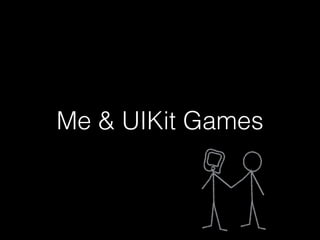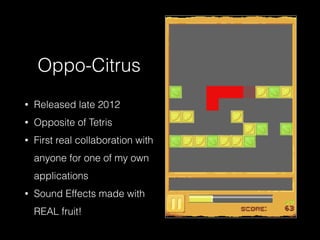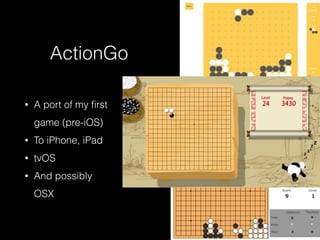Ad
iOS Game Development With UIKit
- 1. iOS Game Development with UIKit Martin Grider @livingtech http://abstractpuzzle.com/ ~ http://chesstris.com/ September 30, 2015
- 2. Overview • Who am I? • Apple native game technologies • UIKit Game Opinions • Me & UIKit Games • About GenericGameModel
- 3. Who am I? Martin Grider @livingtech http://abstractpuzzle.com/ game developer iOS contract / freelance
- 4. IGDATC • International Game Developer’s Association (Twin Cities) • http://igdatc.org/
- 5. Why UIKit? Got to have the Skillz to Pay the Bills! • My Business: I specialize in all native iOS development! • Definitely Not: Android, Phone Gap, Java, PHP • …and now not: Swift (maybe someday?!?) • Quality: 10,000 hours to mastery (maybe debunked*) • Enjoyment: I do what I love. * http://www.popsci.com/article/science/practice-not-important-thought-success-study-says
- 6. I ❤ UIKit ..? • Yes! Maybe. • Maybe I’m just lazy. • But it is very fast to prototype some games in UIKit. • Also: UIKit is the oldest iOS API. Examples are easy to come by, and it’s relatively stable and easy to learn.
- 8. Metal • Hardware-specific graphics API • Introduced in iOS 8 • Closest to the “metal” (CPU / GPU) • Uses a custom shader language • Best performance possible in iOS
- 9. Open GL (ES) • Open Graphics Library (for Embedded Systems) • Cross-platform (this is what ran underneath iOS before Metal) • Also extremely low-level
- 10. Metal / OpenGL ES • Both are fundamentally similar • Useful to know how these work, because they are running “underneath” most game frameworks • But these are APIs for the framework developers (probably not you)
- 11. SpriteKit • A 2D framework for drawing images (sprites) • (You can also draw text, path-based shapes, and video.) • Probably loosely based on Cocos2D (without nearly as many features) • Physics
- 12. SceneKit • 3D framework for drawing 3D models (also to an OpenGL view) • New to iOS in 8 • Some really nice debugging tools
- 13. SpriteKit & SceneKit • Main advantage to these is flexibility / interoperation with other iOS APIs (Core Image, Core Animation, etc.) • So if ^^^ is not you, there are other more flexible options. Note that I will be arguing later, weakly, in favor of UIKit instead of SpriteKit. (It is not a replacement for 3D, however. Unity or Unreal are a better fit there.)
- 14. GameKit, aka Game Center • Leaderboards • Achievements • Challenges • Multiplayer (real-time and asynchronous) • iCloud saved games as of iOS 8
- 15. Game Center • Leaderboards & Achievements • Great “Extrinsic motivators” • Game Center app —> • Also available in your app • Also available as data via the API.
- 17. Game Center • Multiplayer options: • Real-time match making • helps with making the multiplayer connection, (local or internet) • Asynchronous game match making • game data stored in Game Center • All options are very flexible for how many players are allowed, and allow “segmenting” so you can invite a particular subset of players, or specific Game Center Users. • All options allow for either using some built-in View controllers, or doing the matchmaking programmatically.
- 18. GCController • Physical Controller API • Supports iOS bluetooth controllers • Supports Polling for state or change Events • Will work with new Apple TV (including the remote!)
- 19. GamePlayKit • New in iOS 9 • GameplayKit Programming Guide contains links to lots of sample code. • New classes to help with: • Entity / Component architecture • State machines • Rule Systems • Minmax AI • AI behaviors (agents/goals/pathfinding)
- 20. ReplayKit • Share gameplay videos with social media • New in iOS 9 • (Not compatible with AVPlayer)
- 21. UIKit • Highest level Drawing / UI API • Includes many “built-in” controls (buttons, sliders, tables, etc.) • Gesture Recognizers • UIView animateWith… API for motion • Doesn't preclude using Core Graphics / Quartz
- 22. Core Graphics / Quartz • Basically interchangeable terms for the “layers” that back UIView drawing • All UIView objects have a CALayer .layer property • Compossible Animations • Path-based drawing • Transformations • Bitmap rendering — including offscreen! • “easy” shadows, gradients, particles
- 23. CAEmitterLayer • Super simple particles for iOS • Use Particle Playground (in the mac ap store) to prototype:
- 24. UIView Animations • animateWith… family of methods • provide a way to animate view properties based on a specific amount of time (can animate the following: frame, bounds, center, transform, alpha, backgroundColor, contentStretch) • Block-based callbacks for completion • Dynamics: provide some “juiciness” via simple physics • Pro tip: When things start jumping around check the options • Note: you can also animate constraints (if that’s your thing) • Lots of “helpers” out there…
- 25. UIView Animation Helpers • JazzHands — from If This Then That • keyframes & combining animations • can “lock” animations to a scroll view (or your own property/counter!) • JHChainableAnimations — for readable animations! • POP — from Facebook • Also see AGGeometryKit+POP • AHEasing — Awesome set of easing functions • Squash — Brings traditional video animation techniques to UIView (https://github.com/Spaceman-Labs/Squash)
- 26. Cocapods • ObjectAL-for-iPhone — everything audio • GooglePlayGames — for Google Play leaderboards / achievements / etc. (There is even a “Game Center co-existence Guide” here: https:// developers.google.com/games/services/ios/gameCenter) • GenericGameModel — my own small lib for grid- based games (More about this later!) • Others..?
- 28. Why UIKit? • Actually: “Why not any of the previously discussed API or frameworks?” • Essentially, there are better alternatives, mostly • For 3D: Unity, Unreal • For 2D: Unity, HAXE, OpenFrameworks, Moai • These are easier, more cross-platform, less half-assed
- 29. Understand the Game Loop • Every game has a loop. Ideally, a loop runs 30-60 times a second, and handles: • Update • looks at events and input • updates game state • Draw • renders from Game State
- 30. Game Loop, Continued • Drawbacks: • Need to handle the case where it isn’t exactly your target frame rate • Need to be “smart” about what you do in the loop, it’s very easy to do everything (calculate and render) every frame, and this will heat up the device • Without using some kind of animation manager, you need to manage animations yourself (Worth noting that SpriteKit and other frameworks do usually provide this sort of thing for you)
- 31. Game Loop Alternative • Worth noting that iOS apps are already running in a “game loop”, the run loop (NSRunLoop) • In it, everything is event-based: • Responding to touches • Responding to button (UIResponder) events • “Schedule” animations, Apple’s frameworks handle easing • You can also “schedule” game updates, if you want / need to, using dispatch_async()
- 32. UIKit Game Types • Event driven — Turn-based, board games, simple puzzle games • Data Driven — trivia or word games • Location or Map-based games — typically using one of the map frameworks • Others?
- 33. Me & UIKit Games
- 34. ActionChess • My first app • Released Feb 2009 (For iPhone OS 2!!!) • All game logic in a single UIView subclass (😁😰😭)
- 35. For The Win • My project after going contract / freelance • For Tasty Minstrel Games • Released late 2012 • First collaboration with Tysen Streib, AI Developer
- 36. Oppo-Citrus • Released late 2012 • Opposite of Tetris • First real collaboration with anyone for one of my own applications • Sound Effects made with REAL fruit!
- 37. Enter GenericGameModel • Common themes in previous games: • coordinate / grid-based games • "stateful" grid elements • minimal animations required • Began work on GGM during the Overnight Game Jam at 360iDev in September 2012
- 38. Generic Game Model • Model • Update • GGM_BaseModel • Handles game logic • Stores state for each game coordinate • View • Draw • GGM_UIView • Handles touch input • Translates pixel coordinates to model coordinates Natural split felt like:
- 39. Cloud Growth • Unreleased game jam collaboration with fellow iOS developer Levi Brown • First instance of a game using Generic Game Model (GGM)
- 40. Henchmen • Unreleased Ludum Dare game, December 2012 • Subclassed GGM_UIView to support isometric • Only time the isometric class was used, unfortunately.
- 41. DrawCade • Drawing app for the iCade • Jan 2013 — updated to use GGM (in less than a day) • Spent another 2 days making it Universal
- 42. RE@L Match Games • Educational counting apps for RE@L client • 3 apps using similar codebase • published Dec 2013 • Used GGM
- 43. Root Down • Original Board Game • Published December 2013 • Initial prototype in ~6 hours (one evening) using GGM • App store version took ~4 more hours
- 44. OFC Poker • Client application built in ~6 weeks • Feb/March 2014 • Collaboration with Tysen Streib • Used GGM
- 45. Memory Matters • Grant funded client application • Late 2014 • Used GGM
- 46. Catchup • Began project in Jan 2013 • Released August 2014 • Most commercially successful app to date (with more than one ⭐️⭐️⭐️⭐️⭐️ review)! • Another collaboration with AI developer Tysen Streib • First instance of GGM_HexView
- 47. Other Misc GGM Stuff • I have “experimented” with porting GGM_UIView to use SpriteKit • Lost steam after discovering its poor performance in the iOS simulator • Triangle games experiments • Moving toward more “built-in” functionality • Have removed its single dependency
- 48. GGM Example • Sample application (included in Github GGM repository) • Supports square, hex, triangular grid types of arbitrary size • Supports tap and drag gestures
- 49. What’s next for GGM? • More prototypes! (Obviously) • Possibly more grid types • More platforms • possibly porting this to another framework (current front-runners are OpenFL or OpenFrameworks) • tvOS
- 50. ActionGo • A port of my first game (pre-iOS) • To iPhone, iPad • tvOS • And possibly OSX
- 51. Questions?
- 52. References • http://developer.apple.com/metal • http://developer.apple.com/spritekit • http://developer.apple.com/scenekit • https://developer.apple.com/library/ios/documentation/General/Conceptual/ GameplayKit_Guide/ & https://developer.apple.com/library/prerelease/ mac/documentation/GameplayKit/Reference/GameplayKit_Framework • Particle Playground: https://itunes.apple.com/us/app/particle-playground/ id600661093?mt=12 • Nice intro to SceneKit: https://www.objc.io/issues/18-games/scenekit/ • Generic Game Model: https://github.com/mgrider/GenericGameModel



































































































